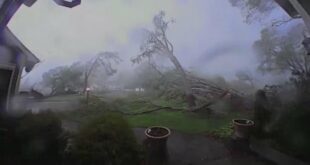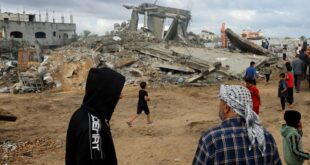Strikes 'will continue at times and places of our choosing,' Biden says

The U.S. military launched an air assault on dozens of sites in Iraq and Syria used by Iranian-backed militias and Iran's Islamic Revolutionary Guard Corps (IRGC) on Friday, in the opening salvo of retaliation for the drone strike that killed three U.S. troops in Jordan last weekend, according to the U.S. military and officials.
President Joe Biden and other top U.S. leaders have been warning for days that the U.S. would strike back at the militias, and they made it clear that it wouldn't be just one hit but would be a "tiered response" over time.
"This afternoon, at my direction, U.S. military forces struck targets at facilities in Iraq and Syria that the IRGC and affiliated militia use to attack U.S. forces," Biden said in a statement. "Our response began today. It will continue at times and places of our choosing."
The massive barrage of strikes by manned and unmanned aircraft hit more than 85 targets at seven locations, including command and control headquarters, intelligence centres, rockets and missiles, drone and ammunition storage sites and other facilities that were connected to the militias or the IRGC's Quds Force, the Guard's expeditionary unit that handles Tehran's relationship and arming of regional militias.
U.S. Central Command said the strikes used more than 125 precision munitions, and they were delivered by numerous aircraft, including long-range bombers flown from the United States. One official, who spoke on condition of anonymity to discuss details of the operation, said B-1 bombers were used.

Two Iraqi militia officials who spoke on condition of anonymity because they were not authorized to speak to journalists said three houses used as headquarters were targeted in al-Qaim, Iraq, including a weapons storage area. An operations headquarters of the Popular Mobilization Forces, a coalition of Iranian-backed militias, in Akashat, Iraq, and weapons stores were targeted.
The assault came just hours after Biden and top defence leaders joined grieving families to watch as the remains of the three army reserve soldiers were returned to the U.S. at Dover Air Force Base in Delaware.
Global Affairs Canada says it strongly condemns the attack against U.S. forces in Jordan.
"We extend our condolences to the families of U.S. personnel killed in the attack. Supporting our partners in the fight against terrorism in the region is something Canada will continue to do," said spokespersonPierre Cuguen. "The stability of the region is a priority for Canada. We will meet these challenges by being pragmatic, and working with key allies and partners."
It was unclear what the next steps will be, or whether the days of U.S. warnings had sent militia members scattering into hiding, making it more difficult for the U.S. to detect and strike them. But it was evident the recent statement released by Kataib Hezbollah, one of the main Iran-backed militias, saying it was suspending attacks on American troops had no impact on the administration's plans to strike back.
The U.S. strikes appeared to stop short of directly targeting Iran or its Revolutionary Guard Quds force within its borders, as the U.S. tries to prevent the conflict from escalating even further. Iran has denied it was behind the Jordan strike.
Today, at my direction, U.S. military forces struck targets in Iraq and Syria that the IRGC and affiliated militia use to attack U.S. forces.<br><br>We do not seek conflict in the Middle East or anywhere else in the world.<br><br>But to all those who seek to do us harm: We will respond.
—@POTUS
Just Friday morning, Iran's hard-line President Ebrahim Raisi reiterated earlier promises by Tehran to potentially retaliate for any U.S. strikes targeting its interests. We "will not start a war, but if a country, if a cruel force wants to bully us, the Islamic Republic of Iran will give a strong response," Raisi said.
In a statement this week, Kataib Hezbollah announced "the suspension of military and security operations against the occupation forces in order to prevent embarrassment to the Iraqi government." But Harakat al-Nujaba, one of the other major Iran-backed groups, vowed Friday to continue military operations against U.S. troops.
The U.S. has blamed the Islamic Resistance in Iraq, a broad coalition of Iran-backed militias, for the deadly attack in Jordan, but it has not yet narrowed it down to a specific group. Kataib Hezbollah is, however, a top suspect.
'Dangerous moment in the Middle East'
Some of the militias have been a threat to U.S. bases for years, but the groups have intensified their assaults amid Israel's war with Hamas. Iran-backed militia groups throughout the region have used the conflict to justify striking Israeli or U.S. interests, including threatening civilian commercial ships and U.S. warships with drones or missiles in almost daily exchanges.

'Tiered' U.S. response to fatal drone attack begins with airstrikes in Syria, Iraq
7 hours ago
Mike Lyons, a fellow at the Modern War Institute at West Point, discusses Friday's U.S. airstrikes on sites in Iraq and Syria used by Iran-backed militias and the Islamic Revolutionary Guard Corps. The strikes came after a drone attack killed three U.S. troops in Jordan last weekend.
Speaking to reporters on Thursday, U.S. Defence Secretary Lloyd Austin said this is "a dangerous moment in the Middle East."
He added, "We will take all necessary actions to defend the United States, our interests and our people. And we will respond when we choose, where we choose and how we choose."
As of Tuesday, Iran-backed militia groups had launched 166 attacks on U.S. military installations since Oct. 18, including 67 in Iraq, 98 in Syria and now one in Jordan, according to a U.S. military official. The last attack was on Monday at an al-Asad airbase in Iraq, and there were no injuries or damage.
The U.S., meanwhile, has bolstered defences at the base in Jordan that was attacked on Sunday, according to a U.S. official.

Iran’s Axis of Resistance and its role in the Israel-Hamas war
3 months ago
Sitting on the edges of the Israel-Hamas war is what's been called the Axis of Resistance, a loose coalition of Iran-backed entities, including Hezbollah, Hamas and the Houthis in Yemen. CBC chief correspondent Adrienne Arsenault breaks down the conditions that could cause the group to engage in a wider war and the firepower behind it.
The Israeli military said its Arrow defence system intercepted a missile that approached the country from the Red Sea, raising suspicion it was launched by Yemen's Houthi rebels. The rebels, allied with Hamas and supported by Iran, did not immediately claim responsibility.
A U.S. official also said the military had taken additional self-defence strikes inside Yemen on Friday against Houthi military targets deemed an imminent threat. Al-Masirah, a Houthi-run satellite news channel, said that British and American forces conducted three strikes in the northern Yemeni province of Hajjah, a Houthi stronghold.
While previous U.S. responses in Iraq and Syria have been more limited, the attack on Tower 22, as the Jordan outpost is known, and the deaths of the three service members has crossed a line, the official said.
That drone attack, which also injured more than 40 service members — largely Army National Guard — was the first to result in U.S. combat deaths from the Iran-backed militias since the war between Israel and Hamas broke out in October. Tower 22 houses about 350 U.S. troops and sits near the demilitarized zone on the border between Jordan and Syria. The Iraqi border is only 10 kilometres away.

U.S. puts Houthis back on list of designated global terrorists
16 days ago
The United States has put Yemen-based Houthi militants back on its list of specially designated global terrorists. In defiance, the Houthis released a new video showing celebrations and rebels marching aboard a hijacked ship in November.
With files from CBC News
*****
Credit belongs to : www.cbc.ca
 MaharlikaNews | Canada Leading Online Filipino Newspaper Portal The No. 1 most engaged information website for Filipino – Canadian in Canada. MaharlikaNews.com received almost a quarter a million visitors in 2020.
MaharlikaNews | Canada Leading Online Filipino Newspaper Portal The No. 1 most engaged information website for Filipino – Canadian in Canada. MaharlikaNews.com received almost a quarter a million visitors in 2020.







